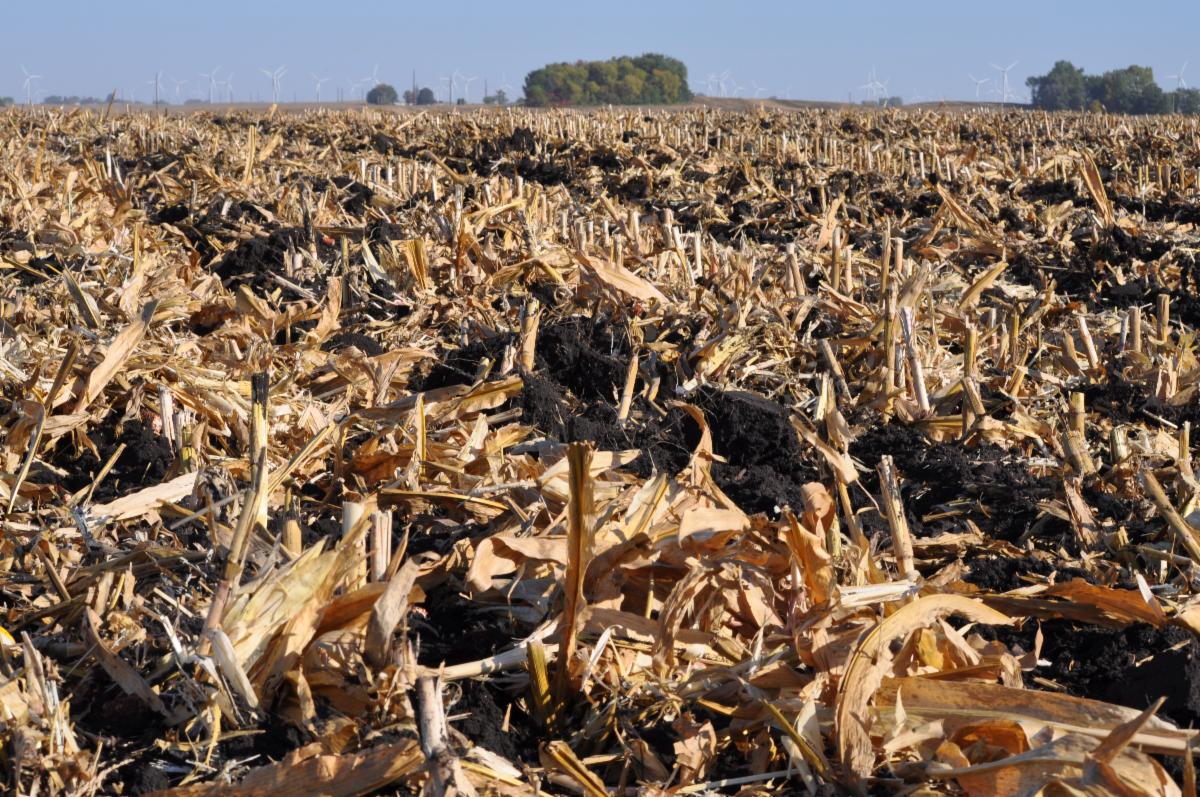Manure: Grounded in Innovation Part 1 of 2
posted on Monday, December 21, 2020
When you think of technology and innovation, you may think of scientists in white coats working in sterile labs, or rockets and space ships exploring far-away planets. But for today’s farmers, technology and innovation are much more grounded. Farm fields are ground zero in our crusade to produce quality food with fewer resources while protecting our environment. Livestock manure plays a critical part in increasing a farm’s resilience to changing weather conditions, the farm’s long-term value and overall health of the soil, and technology is key to making that happen.
 According to Dr. Amy Schmidt, a biosystems engineer at the University of Nebraska-Lincoln and a Donnellson, Iowa, native, manure is a win for farmers and their fields. "Over time, manure can improve the moisture holding capacity of soil; the permeability of soil; the efficiency of nutrient cycling process within soil and the efficiency of the soil in delivering plant available nutrients to crops." Schmidt continued, "A lot of these characteristics in the long term are important to the resilience of that cropping system and maybe the value of the land itself down the road."
According to Dr. Amy Schmidt, a biosystems engineer at the University of Nebraska-Lincoln and a Donnellson, Iowa, native, manure is a win for farmers and their fields. "Over time, manure can improve the moisture holding capacity of soil; the permeability of soil; the efficiency of nutrient cycling process within soil and the efficiency of the soil in delivering plant available nutrients to crops." Schmidt continued, "A lot of these characteristics in the long term are important to the resilience of that cropping system and maybe the value of the land itself down the road."
Livestock farmers are a key partner in helping grain farmers improve their soil health. At Iowa Select Farms, we partner with 1,700 grain farmers and 65 custom manure application teams to supply nutrients and organic matter to cropland in nearly 60 Iowa counties.
A Farmer's Approach - 4R Stewardship
Ensuring the health of people, soil and water while improving the resilience of cropping systems is best achieved by following “The 4R’s of Nutrient Management,” practices that are embraced by Iowa Select Farms. The 4R’s help farmers achieve goals on their farm related to production, profitability, environmental protection and sustainability while supplying cropland with vital nutrients that support plant growth. With crops out of the field, now is the time to look at replenishing nutrients for use by the next crop.
1. Right Source - the good stuff
 Manure is an organic fertilizer that provides benefits beyond supplying crop nutrients; organic matter and microbes in manure can help improve soil porosity, nutrient cycling efficiency and physical structure. According to Schmidt, “Whether nutrients are applied to soil in the form of manure or manufactured fertilizer, plants don't know the difference. They will use organic and inorganic nutrients from the soil regardless of where they came from.”
Manure is an organic fertilizer that provides benefits beyond supplying crop nutrients; organic matter and microbes in manure can help improve soil porosity, nutrient cycling efficiency and physical structure. According to Schmidt, “Whether nutrients are applied to soil in the form of manure or manufactured fertilizer, plants don't know the difference. They will use organic and inorganic nutrients from the soil regardless of where they came from.”
She continued, "But, soil will respond differently to manure and inorganic fertilizers. When commercial fertilizer has been used by plants or lost to water or air due to chemical changes, there is no fertility benefit remaining. Manure, on the other hand, contains two additional components that aren’t found in commercial fertilizer: organic matter and microbes. Organic matter is food to earthworms, mites, beetles and many soil microorganisms. Adding both organic matter and microorganisms to soil promotes aggregation of soil particles – the process of small soil particles sticking together to form larger soil aggregates – reduces erosion risks, improves moisture holding capacity and improves infiltration. Over time, manure improves soil conditions."
2. Right Rate
 Prior to any application, Iowa Select Farms works closely with its farmer network and soil scientists to identify fields and soils that need manure nutrients and to determine the appropriate manure application rate based on the crop nutrient needs and the soil and manure characteristics.
Prior to any application, Iowa Select Farms works closely with its farmer network and soil scientists to identify fields and soils that need manure nutrients and to determine the appropriate manure application rate based on the crop nutrient needs and the soil and manure characteristics.
3. Right Time
 Ensuring fertilizer is applied when crops can use it, or when it can be safely “stored” in the soil, is imperative for a successful stewardship program. Schmidt says, “Risks for nitrogen losses via leaching and phosphorus losses via runoff are a concern. So avoiding fall application until soil temperature drops below 50 degrees F and avoiding surface application of manure when precipitation is imminent are just two examples of how application timing can contribute to responsible nutrient management. One advantage with manure is that organic nitrogen present in manure solids is a slow release fertilizer, meaning it becomes available when soil organisms break down organic matter.”
Ensuring fertilizer is applied when crops can use it, or when it can be safely “stored” in the soil, is imperative for a successful stewardship program. Schmidt says, “Risks for nitrogen losses via leaching and phosphorus losses via runoff are a concern. So avoiding fall application until soil temperature drops below 50 degrees F and avoiding surface application of manure when precipitation is imminent are just two examples of how application timing can contribute to responsible nutrient management. One advantage with manure is that organic nitrogen present in manure solids is a slow release fertilizer, meaning it becomes available when soil organisms break down organic matter.”
4. Right Place
 The “right place” to apply manure can refer to surface vs. sub-surface application. Injecting manure below the soil surface or incorporating surface applied manure within 24 hours can reduce odors that may be a nuisance to neighbors, mitigate runoff of nutrients, and conserve nitrogen for use by crops. According to the United States Department of Agriculture, “Manure injection or incorporation reduces manure nitrogen losses to the atmosphere by reducing ammonia volatilization and improves water quality by reducing manure nitrogen and phosphorus losses via surface runoff.” Manure “setbacks” or separation distances refer to limits on how close manure can be stored or applied to creeks, rivers, lakes, drinking water wells, tile inlets, residences and other sensitive areas. Some may be surprised to learn that these same types of restrictions do not apply to applications of commercial fertilizers, though inorganic fertilizer still poses risks to surface and ground water.
The “right place” to apply manure can refer to surface vs. sub-surface application. Injecting manure below the soil surface or incorporating surface applied manure within 24 hours can reduce odors that may be a nuisance to neighbors, mitigate runoff of nutrients, and conserve nitrogen for use by crops. According to the United States Department of Agriculture, “Manure injection or incorporation reduces manure nitrogen losses to the atmosphere by reducing ammonia volatilization and improves water quality by reducing manure nitrogen and phosphorus losses via surface runoff.” Manure “setbacks” or separation distances refer to limits on how close manure can be stored or applied to creeks, rivers, lakes, drinking water wells, tile inlets, residences and other sensitive areas. Some may be surprised to learn that these same types of restrictions do not apply to applications of commercial fertilizers, though inorganic fertilizer still poses risks to surface and ground water.
Pumping Technology Into Farming
A key partner in implementing the 4Rs at Iowa Select Farms are the 65 custom nutrient applicators that precisely apply nutrients according to state, federal and company regulations. These small businesses are quick to improve their fleet of equipment with some of the latest technologies like tablet-controlled pumps, draglines, tanks, low-disturbance row units on toolbars, and much more
Manure Injection
 Arguably the biggest advancement in manure application technology over the past several decades is the adoption of injection equipment by farmers and custom applicators. Manure injection technology was introduced in the late 1990s and met with curiosity, so much so that Iowa Select Farms conducted a field day to demonstrate the technology to media. Injection was lauded by neighbors for the reduction in odors and farmers for its improvement in nutrient retention.
Arguably the biggest advancement in manure application technology over the past several decades is the adoption of injection equipment by farmers and custom applicators. Manure injection technology was introduced in the late 1990s and met with curiosity, so much so that Iowa Select Farms conducted a field day to demonstrate the technology to media. Injection was lauded by neighbors for the reduction in odors and farmers for its improvement in nutrient retention.
Injection of manure ensures the final R of the 4Rs – Right Place – or staying in place. Dr. Dan Andersen, with Iowa State University Extension uses a delicious prop to explain how injection works. With his Jell-O Poke Cake, Dr. Andersen substitutes cake for soil to illustrate how a porous structure holds liquid, for which he substitutes Jell-O for manure. Now, we can all agree that this may seem a little silly, but the analogy works!
 “The liquid fills the injection slot and then wicks out to the side and downward,” Andersen says. “The sideways movement is caused by capillary pull from the soil while the downward movement is caused by gravity. The water (manure) keeps spreading out until the soil has enough capillary pull to hold onto what is remaining. When we put manure on, we want the soil to be able to hold all the manure in the root zone, where the nutrients in the manure stay until our crops can use them.”
“The liquid fills the injection slot and then wicks out to the side and downward,” Andersen says. “The sideways movement is caused by capillary pull from the soil while the downward movement is caused by gravity. The water (manure) keeps spreading out until the soil has enough capillary pull to hold onto what is remaining. When we put manure on, we want the soil to be able to hold all the manure in the root zone, where the nutrients in the manure stay until our crops can use them.”
 While crop farmers and manure applicators work hand-in-hand to adopt new methods and technology to reap the full benefits of manure, the environmental services team at Iowa Select Farms is putting more data to work through the introduction of the Pumper Portal. Stay tuned for Part II of the story!
While crop farmers and manure applicators work hand-in-hand to adopt new methods and technology to reap the full benefits of manure, the environmental services team at Iowa Select Farms is putting more data to work through the introduction of the Pumper Portal. Stay tuned for Part II of the story!
Subscribe to our newsletter: Get fresh articles delivered straight to your inbox.
Subscribe